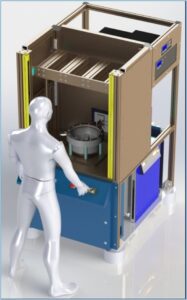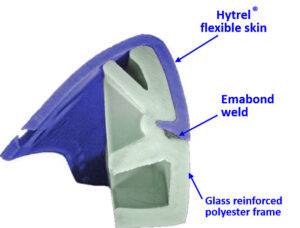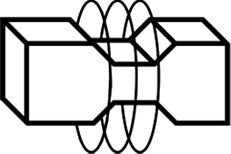How Emabond Welding is Better Than Spin Welding for Versatility and Performance
 Plastic welding is an important process used to make many products, from medical devices to car parts. Two common ways to weld plastics are Emabond welding and spin welding. While both methods work, they have big differences when it comes to performance and versatility. Together, we’ll explore how these two methods compare and show why Emabond welding is the better choice for complex and high-demand projects.
Plastic welding is an important process used to make many products, from medical devices to car parts. Two common ways to weld plastics are Emabond welding and spin welding. While both methods work, they have big differences when it comes to performance and versatility. Together, we’ll explore how these two methods compare and show why Emabond welding is the better choice for complex and high-demand projects.
What is Spin Welding?
Spin welding is a process that uses friction and rotation to create heat and join plastic parts. In this method, one part spins while the other stays still. The friction between them generates heat, and when the plastic is hot enough, the two parts are pressed together to form a solid bond as they cool down.
However, spin welding has some clear limitations. It only works for circular parts because the spinning action is what creates the heat. This makes it less useful for parts that have different shapes or complex designs. Also, spin welding can have trouble with very thin parts, limiting its use in some industries.
What is Emabond Welding?
Emabond welding is a more advanced plastic welding method that uses high-frequency energy and special materials called electromagnetic susceptors to heat the bond line where the plastic parts will join. Instead of relying on friction, the Emabond process focuses heat directly where it’s needed. This creates a strong, airtight bond that works well for high-pressure applications.
Emabond welding has several advantages over traditional welding methods. It uses precise heat and pressure to make sure each weld is strong and consistent. Whether you’re working with large or small parts, the Emabond process delivers clean, leak-proof seals that don’t require adhesives or fasteners.
Versatility: Complex Shapes vs. Circular Parts
One of the biggest problems with spin welding is that it only works on circular parts. This limits its use in industries that need to join parts with more complex shapes or designs. Emabond welding is much more versatile. It can weld parts with complex 3D shapes, join different types of materials, and handle parts of many different designs. This makes it the better option for industries like medical devices, transportation, and consumer products, where unusual shapes and precise welding are important.
For example, in the medical industry, devices often have small, complex parts made from different materials. Spin welding wouldn’t work well for these projects because it can’t handle the complex shapes. But Emabond’s precise heating process is perfect for this kind of work, providing strong and clean welds no matter the shape or material of the parts.
Strength and Sealing Capabilities
When comparing the strength of the welds, Emabond welding easily outperforms spin welding. Spin welding can create solid bonds, but it struggles with high-pressure or leak-proof seals. The friction-based process may leave small gaps that can weaken the bond under extreme conditions.
On the other hand, Emabond welding excels in high-pressure applications, creating airtight, leak-proof seals. This makes it ideal for industries like water filtration and transportation, where the welds must be able to handle stress and pressure without failing. The heat in the Emabond process is applied precisely, ensuring the bond is strong and free of weak spots.
Precision and Clean Finishing
 Spin welding often creates a layer of extra material called “flash” around the weld due to the friction between the parts. This flash needs to be removed afterward, adding extra steps to the process and increasing production time and cost. Spin welding can also leave the surface of the parts looking less clean and polished, which may be a problem for products where appearance matters.
Spin welding often creates a layer of extra material called “flash” around the weld due to the friction between the parts. This flash needs to be removed afterward, adding extra steps to the process and increasing production time and cost. Spin welding can also leave the surface of the parts looking less clean and polished, which may be a problem for products where appearance matters.
Emabond welding avoids these issues. Since the heat is applied directly to the bond line, there’s no flash, and the result is a smooth, clean weld. This makes Emabond a great choice for industries like office furniture and consumer products, where a clean and visually appealing finish is important. Emabond also doesn’t require surface treatment before welding, which saves time and effort in production.
Automation and Production Efficiency
Spin welding is mostly a manual process, which makes it hard to automate for large-scale production. Businesses that want to increase their production levels would need to invest in extra equipment and labor, which can be costly and time-consuming.
In contrast, Emabond welding can be easily automated and integrated into production lines. Emabond offers customized automation solutions that fit different needs, whether it’s for smaller-scale operations or large production runs. This flexibility makes Emabond a more efficient option for industries with high-volume production demands. With automated Emabond systems, businesses can increase their output and improve efficiency without the need for extra labor.
Why Emabond is the Better Choice
When we compare Emabond welding and spin welding, the differences are clear. Spin welding is useful for circular parts, but it has serious limits when it comes to shape and performance. It can’t handle complex geometries, different materials, or high-pressure seals. Emabond welding, on the other hand, provides stronger bonds, cleaner finishes, and much greater flexibility. It works with complex shapes, creates strong, leak-proof seals, and doesn’t need extra finishing steps like surface treatment or flash removal.
For businesses that need a reliable, efficient, and flexible plastic welding solution, Emabond offers clear advantages. Whether your project involves large-scale production or requires welding dissimilar materials with precision, Emabond is the superior choice. Contact Emabond today to learn how our RF welding technology can help you improve your production process and deliver high-quality results.

